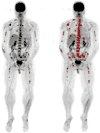Assessment of Total Lesion Glycolysis by 18F FDG PET/CT Significantly Improves Prognostic Value of GEP and ISS in Myeloma
- PMID: 27698001
- PMCID: PMC5777601
- DOI: 10.1158/1078-0432.CCR-16-0235
Assessment of Total Lesion Glycolysis by 18F FDG PET/CT Significantly Improves Prognostic Value of GEP and ISS in Myeloma
Abstract
Purpose: Fluorine-18 fluorodeoxyglucose positron emission tomography with CT attenuation correction (18F-FDG PET/CT) is useful in the detection and enumeration of focal lesions and in semiquantitative characterization of metabolic activity (glycolytic phenotype) by calculation of glucose uptake. Total lesion glycolysis (TLG) and metabolic tumor volume (MTV) have the potential to improve the value of this approach and enhance the prognostic value of disease burden measures. This study aims to determine whether TLG and MTV are associated with progression-free survival (PFS) and overall survival (OS), and whether they improve risk assessments such as International Staging System (ISS) stage and GEP70 risk.Experimental Design: 192 patients underwent whole body PET/CT in the Total Therapy 3A (TT3A) trial and were evaluated using three-dimensional region-of-interest analysis with TLG, MTV, and standard measurement parameters derived for all focal lesions with peak SUV above the background red marrow signal.Results: In multivariate analysis, baseline TLG > 620 g and MTV > 210 cm3 remained a significant factor of poor PFS and OS after adjusting for baseline myeloma variables. Combined with the GEP70 risk score, TLG > 205 g identifies a high-risk-behaving subgroup with poor expected survival. In addition, TLG > 205 g accurately divides ISS stage II patients into two subgroups with similar outcomes to ISS stage I and ISS stage III, respectively.Conclusions: TLG and MTV have significant survival implications at baseline and offer a more precise quantitation of the glycolytic phenotype of active disease. These measures can be assessed more readily than before using FDA-approved software and should be standardized and incorporated into clinical trials moving forward. Clin Cancer Res; 23(8); 1981-7. ©2016 AACR.
©2016 American Association for Cancer Research.
Conflict of interest statement
Figures




Similar articles
-
Artificial intelligence-based, volumetric assessment of the bone marrow metabolic activity in [18F]FDG PET/CT predicts survival in multiple myeloma.Eur J Nucl Med Mol Imaging. 2024 Jul;51(8):2293-2307. doi: 10.1007/s00259-024-06668-z. Epub 2024 Mar 8. Eur J Nucl Med Mol Imaging. 2024. PMID: 38456971 Free PMC article.
-
Prognostic value of metabolic tumor burden from (18)F-FDG PET in surgical patients with non-small-cell lung cancer.Acad Radiol. 2013 Jan;20(1):32-40. doi: 10.1016/j.acra.2012.07.002. Epub 2012 Sep 19. Acad Radiol. 2013. PMID: 22999369
-
Prognostic value of whole-body total lesion glycolysis at pretreatment FDG PET/CT in non-small cell lung cancer.Radiology. 2012 Aug;264(2):559-66. doi: 10.1148/radiol.12111148. Epub 2012 Jun 12. Radiology. 2012. PMID: 22692034
-
Prognostic value of volume-based metabolic parameters of 18F-FDG PET/CT in ovarian cancer: a systematic review and meta-analysis.Ann Nucl Med. 2018 Dec;32(10):669-677. doi: 10.1007/s12149-018-1289-1. Epub 2018 Aug 12. Ann Nucl Med. 2018. PMID: 30101392
-
Prognostic Value of Volumetric Parameters of Pretreatment 18F-FDG PET/CT in Esophageal Cancer: A Systematic Review and Meta-analysis.Clin Nucl Med. 2018 Dec;43(12):887-894. doi: 10.1097/RLU.0000000000002291. Clin Nucl Med. 2018. PMID: 30300200
Cited by
-
Prognostic significance of 18F-sodium fluoride in newly diagnosed multiple myeloma patients.Am J Nucl Med Mol Imaging. 2020 Aug 25;10(4):151-160. eCollection 2020. Am J Nucl Med Mol Imaging. 2020. PMID: 32929393 Free PMC article.
-
Imaging and biopsy of HIV-infected individuals undergoing analytic treatment interruption.Front Med (Lausanne). 2022 Aug 22;9:979756. doi: 10.3389/fmed.2022.979756. eCollection 2022. Front Med (Lausanne). 2022. PMID: 36072945 Free PMC article.
-
Cluster analysis of autoencoder-extracted FDG PET/CT features identifies multiple myeloma patients with poor prognosis.Sci Rep. 2023 May 15;13(1):7881. doi: 10.1038/s41598-023-34653-3. Sci Rep. 2023. PMID: 37188831 Free PMC article.
-
Interest of Pet Imaging in Multiple Myeloma.Front Med (Lausanne). 2019 Apr 9;6:69. doi: 10.3389/fmed.2019.00069. eCollection 2019. Front Med (Lausanne). 2019. PMID: 31024917 Free PMC article. Review.
-
Solitary Extramedullary Plasmacytoma of the Cricoid Cartilage-Case Report.Front Oncol. 2017 Nov 27;7:284. doi: 10.3389/fonc.2017.00284. eCollection 2017. Front Oncol. 2017. PMID: 29230383 Free PMC article.
References
-
- Zamagni E, Patriarca F, Nanni C, Zannetti B, Englaro E, Pezzi A, et al. Prognostic relevance of 18-F FDG PET/CT in newly diagnosed multiple myeloma patients treated with up-front autologous transplantation. Blood. 2011 Dec 1;118(23):5989–95. - PubMed
-
- Hillengass J, Fechtner K, Weber MA, Bäuerle T, Ayyaz S, Heiss C, et al. Prognostic significance of focal lesions in whole-body magnetic resonance imaging in patients with asymptomatic multiple myeloma. J Clin Oncol. 2010 Mar 20;28(9):1606–10. - PubMed
Publication types
MeSH terms
Substances
Grants and funding
LinkOut - more resources
Full Text Sources
Other Literature Sources
Medical

